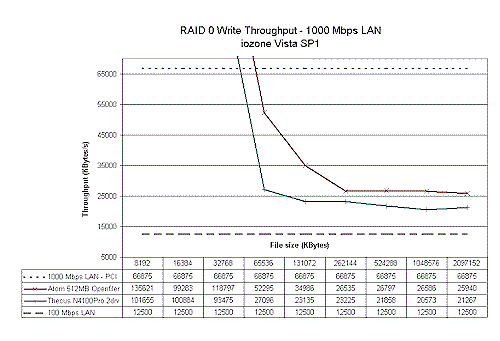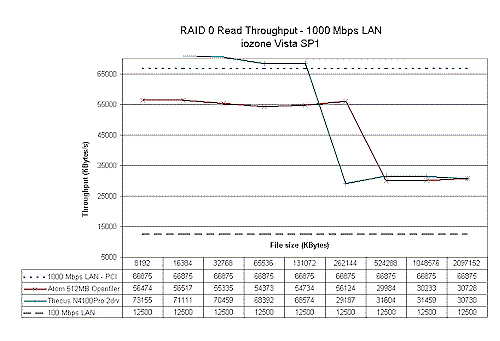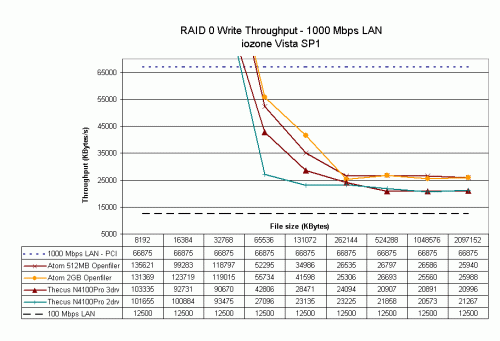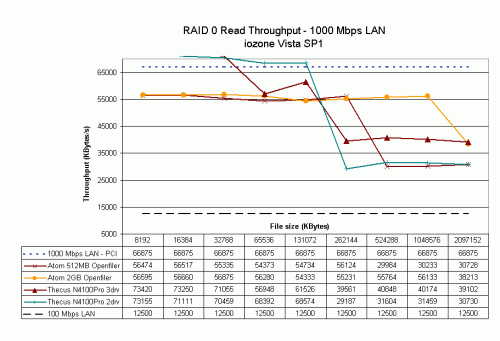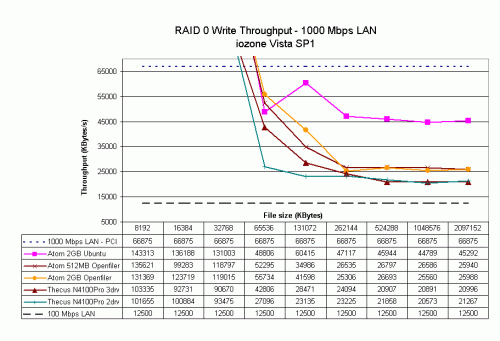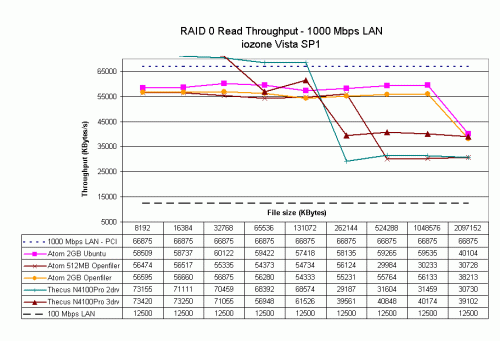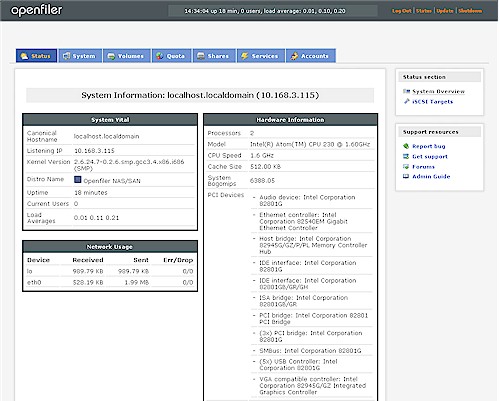Introduction
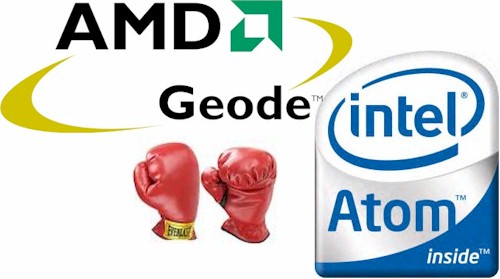
I would have expected that Atom-powered NASes would be flooding the market by now, pushing aside the current crop of low-to-mid priced products based on Marvell’s ORION Media Vault Processors.
But so far, the only way to get an Atom-based NAS has been to roll your own. Thecus, however, has selected AMD’s Geode low-cost CPU to power its N4100PRO and upcoming N3200PRO. So I was able to get a feel for the Geode’s performance when I recently reviewed the N4100PRO.
Since I also had performance data for my DIY Atom NAS, I wanted to include an Atom / Geode comparison in the N4100PRO review. But as I went to write up the comparison, I found that my Atom data wasn’t really suited for a fair comparison.
So I went back to the bench, and ran new tests on both the Atom-based NAS and the Thecus N4100PRO. The goal was to get as good of an apples-to-apples comparison as I could get, considering that I couldn’t exactly match operating systems.
The Contenders
To review, Table 1 shows the components used in the DIY Atom NAS. The configuration is the same as used in the Atom DIY articles, except for two changes: 512 MB vs. 2 GB of RAM; and Openfiler 2.3 instead of Ubuntu Server for the OS.
| Component | |
|---|---|
| CPU | Intel Atom |
| Motherboard | Intel BOXD945GCLF |
| RAM | Kingston 512 GB DDR2 667 (PC2 5300) |
| Data Drives | Hitachi Deskstar HDS721680PLA380 80GB 7200RPM 3.0 Gb/s SATA 8MB |
| Ethernet | Intel PRO/1000 PCI |
| OS | Openfiler 2.3 |
Table 1: Atom NAS component summary
I reduced the RAM to try to match the miserly 256 MB of RAM that Thecus included in the 4100PRO. But the smallest DIMM I had on hand was 512 MB, so that’s what I used. As for the OS, I thought I would give Openfiler a shot, since I had yet to try it and it had been suggested over in the Forums.
Table 2 shows the same component information for the N4100PRO. As noted earlier, there is only 256 MB of RAM. Both products have PCI-based Ethernet, which will limit uncached top speed to just shy of 67 MB/s.
| Component | |
|---|---|
| CPU | AMD Geode LX800 |
| Motherboard | Thecus custom |
| RAM | DSL 256 GB DDR 400 SoDIMM |
| Data Drives | WDC WD1600AAJS-0 Caviar Blue 160 GB, 7200 RPM 3.0 Gb/s, 8 MB |
| Ethernet | Intel 82541 PCI gigabit Ethernet controller |
| OS | Openfiler 2.3 |
Table 2: Thecus N4100PRO component summary
Previous experiments included trying Western Digital’s VeliciRaptor drives, which I didn’t find made much difference in performance. So I didn’t move drives from NAS to NAS, since both sets of drives were 7200 RPM SATA with 8 MB caches. I did, however, use only two drives in the N4100PRO’s RAID 0 array, to match the maximum capacity of the Atom NAS.
The Results
All testing was done using iozone running on the "New NAS Test Bed" machine (Core 2 Duo E4400, 512 MB) that I have been using for testing in the Fast NAS series. I ran all tests using Vista SP1, since it seems to give tested NASes a bit of a speed boost over XP SP2.
Figure 1 shows write results for as apples-to-apples comparison as I could get. The more rapid falloff from cached performance for the 4100PRO is due to its smaller RAM size. But once both products get beyond caching effects, the Atom machine has about a 20% advantage. Both NASes, however, deliver RAID 0 write performance in the 20 MB/s range, which is above the 100 Mbps LAN theoretical line, but significantly below the 1000 Mbps PCI actual line.
Figure 1: Atom vs. Geode – Write
Figure 2 shows read results, which show that the products have swapped lead positions for cached performance. The Geode-powered N4100PRO stays up above the 68 MB/s line until it hits its 256 MB RAM size, while the Atom NAS maxes out at around 55 MB/s. Once both products go past their RAM size, however, read speeds are virtually identical at around 31 MB/s.
Figure 2: Atom vs. Geode – Read
Since I had everything set up, I thought I’d vary a few hardware elements to see how they would effect performance. For the Atom NAS I boosted RAM size to 2 GB, the same configuration I used when I ran it with FreeNAS and Ubuntu Server. For the Thecus, I decided to add a third drive to the RAID 0 array.
Figures 3 and 4 show the new results added to the original, neither of which seems to make much of a difference in performance.
Figure 3: Atom vs. Geode w/ hardware variations – Write
The third drive in the N4100PRO flattens the cached to non-cached line slope only a bit, as does the additional RAM in the Atom NAS. But once the non-cached filesizes are hit, there is no difference from the hardware changes.
Figure 4: Atom vs. Geode w/ hardware variations – Read
As I noted earlier, I decided to use Openfiler 2.3 to run the Atom NAS data. But since I had comparable data from my Ubuntu tests, I thought I’d throw that into the comparison, too, shown in Figures 5 and 6.
Figure 5: Atom vs. Geode w/ hardware variations and Ubuntu – Write
I was quite surprised to see the difference that Ubuntu made in write performance and it even managed to raise read performance a bit (at the expense of eliminating a speed boost at smaller file sizes. I used ext3 and 64K stripe sizes when formatting the RAID 0 array in both cases. So I can only attribute the difference in performance to something else in the Ubuntu Server distro.
Figure 6: Atom vs. Geode w/ hardware variations and Ubuntu – Read
OpenFiler
By the way, using Openfiler wasn’t the smoothest experience, although things started out on a positive note. I used the Openfiler GUI installer, which was very professionally done and relatively straightforward. It did take a good deal of time to complete (at least 15 minutes, perhaps more), maybe because it was downloading modules automatically as part of the install.
Figure 7: Openfiler Status screen
I installed Openfiler to an old 10 GB IDE drive so that the two SATA drives would be free for my RAID 0 array. But when I finished the boot, the two SATA drives didn’t appear! Long story short, I had to resort to logging into the consule as root and running fdisk to kill the partitions left over from Ubuntu server before I was finally able to mount the drives and configure them into a RAID 0 array.
I hit two other gotchas when I tried to map the RAID 0 share on the Vista machine. The first was that Openfiler doesn’t provide a way to set the Windows workgroup name. So the only way to find the share was to use the UNC notation and IP address, i.e. //10.168.3.115 in my case.
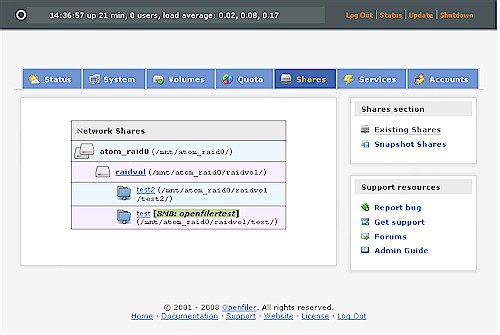
Figure 8: Openfiler Shares screen
But even once I found the share, I wasn’t able to map it. That turned out to be caused by Openfiler’s default notation for SMB shares that has the format of volumegroup.volumename.directory, which Windows apparently doesn’t like. I had to use the "Override SMB/Rsync share name:" option in the Share edit screen to enter a simpler name without the dots and was then able to map it as a drive.
Closing Thoughts
So is AMD’s Geode or Intel’s Atom better for making a faster, cheaper NAS? I think where I end up is that both look like they are capable of producing mid-market NASes that are in the same performance neighborhood.
If Thecus’ pricing for the N4100PRO and upcoming N3200PRO is any indication, however, these processors aren’t going to enable NASes that are cheaper than ones using Marvell’s Orion. As small and low-powered as they are, the Atom and Geode are still general purpose CPUs, not application-specific network storage processors.
This means that the boards that they sit on look more like those in the current top-of-the-chart NASes like the Intel SS4200-E, Qnap TS-509 Pro and Synology DS508, which use Intel Celeron M and Freescale PowerQUICC III CPUs. The higher parts count that these CPUs require means that I don’t think they will be joining the ranks of $200 NASes anytime soon. But they should enable NASes that price out and perform somewhere in between current entry-level and "Pro" grade products.

